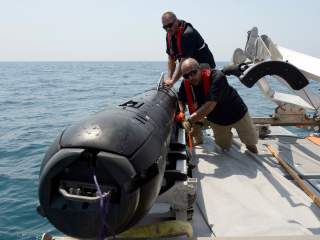Robotic Submarines: How the Navy and Boeing Could Make History
A compliment, and not a replacement, to manned systems.
Key point: The Navy is investing in unmanned platforms for a new age of warfare.
The U.S. Navy has ordered from Boeing four huge robotic submarines, potentially signally an effort to deploy a large number of crewless undersea boats alongside traditional, manned submarines.
The Navy's $43-million purchase of four Orca Extra Large Unmanned Undersea Vehicles, or XLUUVs, comes as the fleet struggles to build enough new manned submarines to replace older vessels that are decommissioning as their nuclear cores wear out.
"Boeing based its winning Orca XLUUV design on its Echo Voyager unmanned diesel-electric submersible," Ben Werner explained at USNI News.
"The 51-foot-long submersible is launched from a pier and can operate autonomously while sailing up to 6,500 nautical miles without being connected to a manned mother ship, according to the Navy," Werner continued.
"Eventually, the Navy could also use the Orca XLUUV for mine countermeasures, anti-submarine warfare, anti-surface warfare, electronic warfare and strike missions," according to a Navy outline of the system’s capability development.
Orca features an open-architecture design. The robotic sub "will be modular in construction with the core vehicle providing guidance and control, navigation, autonomy, situational awareness, core communications, power distribution, energy and power, propulsion and maneuvering and mission sensors," Seapower quoted the Navy as stating.
"The Orca XLUUV will have well-defined interfaces for the potential of implementing cost-effective upgrades in future increments to leverage advances in technology and respond to threat changes."
Orca could help to fill a yawning gap in the American submarine fleet. In December 2016, the U.S. Navy announced it needed 66 nuclear-powered attack subs, or SSNs, to meet regional commanders' needs. But in early 2019 it had just 51 attack boats.
The U.S. Navy in recent years has been buying new Virginia-class attack submarines at a rate of two per year, hoping to mitigate an attack-sub shortfall during the mid-2020s. But the attack-sub force still could decline to a low of 42 in 2028 as old Los Angeles-class boats leave the fleet in large numbers.
"Where we sit today is, we can’t build ships and deliver them in time to fill in that dip," Vice Adm. Bill Merz, a deputy chief of naval operations, told U.S. senators.
While American submarines are more sophisticated than are most subs belonging to rival fleets, there might be too few U.S. boats to, say, quickly respond to a Chinese invasion of Taiwan.
As recently as 2013, the U.S. Navy could deploy on short notice no more than eight attack submarines to the western Pacific, according to Adm. Cecil Haney, then the commander of Pacific Fleet submarines.
Moreover, U.S. subs on average are around 400 feet long and displace around 6,000 tons, making them too big for operations in shallow, crowded waters such as those of the Taiwan Strait.
In early 2019 China possessed around 50 diesel-powered attack submarines, or SSKs, and six nuclear-powered attack subs and was on track to add several more boats by 2020, the U.S. Defense Intelligence Agency reported in February 2019.
The People's Liberation Army Navy included 17 of the latest Yuan-class boats with air-independent propulsion, or AIP. A Yuan boat is around 250 feet long and displaces around 2,500 tons of water.
"It is conceivable that an adept PLAN submarine captain ... could take advantage the Yuan’s shallow draft and wedge the SSK into a difficult-to-access channel or maritime feature, and thereby forcing higher-technology SSNs to fight on unfavorable terrain whose geography and acoustic signatures favor the defender," Henry Holst explained in an essay for the U.S. Naval Institute.
An Orca is even smaller than a Yuan is. Assuming the U.S. Navy can refine the robotic boat's command-and-control systems, artificial intelligence, sensors and weapons, in theory the Orca could become a capable shallow-water fighter.
Not coincidentally, the U.S. Navy also is eyeing robotic vessels to bolster the surface fleet. Cheaper to build than today ship's are and expendable, unmanned surface warships could help the Navy quickly to grow -- and could allow the fleet to develop new tactics for battling a high-tech foe.
"Part of the value of having unmanned surface vehicles is you can get capacity at a lower cost," Rear Adm. John Neagley, the Navy’s executive for unmanned and small warships, told Breaking Defense.
The same applies to the undersea fleet.
David Axe serves as Defense Editor of the National Interest. He is the author of the graphic novels War Fix, War Is Boring and Machete Squad. This article first appeared last February.
Image: U.S. Navy.

